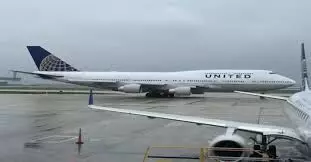United Airlines Flight UA770 Makes Emergency Landing at Heathrow After Mid-Air Technical Anomaly
United Airlines Flight UA770 diverts to Heathrow after mid-air technical issue. All 257 passengers safe; crew praised for calm, expert handling.[[[[
image for illustrative purpose

When a technical issue was discovered mid-flight on United Airlines Flight UA770, a Boeing 787-9 Dreamliner travelling from Barcelona to Chicago, the usual transatlantic flight descended into a high-stakes emergency.
At 37,000 feet over the Atlantic, the aircraft carrying 12 crew members and 257 passengers had reached cruising altitude when the crew became aware of what they believed to be a cabin pressurisation problem. In order to alert air traffic control to prepare for a quick diversion, the pilots, who had been trained to respond quickly in such situations, announced a general emergency code of "7700."
Calm in the Face of Crisis:
A Controlled Emergency At approximately 2:30 PM CEST, flight UA770 took off from Barcelona under clear skies. About 90 minutes into the trip, the pilots noticed the issue and decided to reroute the aircraft to London Heathrow, which is one of the most emergency-prepared airports in Europe.
Even though a pressurisation fault can be extremely uncomfortable or even harmful to one's health, the diversion was carried out with amazing accuracy. Emergency vehicles greeted the aircraft as a precaution after it made a safe landing on Runway 27R at 4:55 PM BST. No one was hurt.
Reactions from Passengers: Calm Management, Easy Management
Rather than panic, passengers reported feeling uncertain. The crew effectively reassured passengers and kept an eye on safety protocols while the captain explained the diversion to the cabin in a cool but firm manner. The absence of oxygen masks showed that everything were still under control.
A traveler recalled, "There was a sense of togetherness." "The difference was entirely due to the crew's professionalism."
When passengers landed, they were met by United Airlines employees at Gate B44, who helped them rebook and gave them hotel and meal coupons.
Technology, Training, and Coordination Behind the Scenes
The effective emergency response demonstrated how cutting-edge aviation technology can be integrated with global coordination. Real-time aircraft health monitoring on the Boeing 787-9 Dreamliner started sending vital information to European air traffic control and United's operations centre as soon as the problem was identified.
UA770 was securely navigated across the airspace of Spain, France, and the UK in a matter of minutes thanks to EUROCONTROL's flawless coordination. The Instrument Landing System (ILS) at Heathrow was one of the advanced systems that made the touchdown seamless.
Crew training was also very important. In order to handle in-flight emergencies, pilots and cabin crew go through extensive simulations, and their compliance with procedures guaranteed a safe conclusion.
The Reaction of United Airlines and the Effect on the Industry
In a statement, United Airlines reaffirmed that passenger safety is still their top priority. For a thorough examination, the impacted aircraft (tail number N26902) was grounded. Although a final report is still pending, preliminary findings point to a pressurisation system malfunction.
Due to technical or medical issues, United Airlines had to make several emergency diversions in 2025, which this occurrence adds to. Even though they only happen once per 1,500 flights, these incidents serve as a reminder of the airline industry's dedication to putting safety before schedule.
The results could have an impact on future maintenance procedures and crew training requirements after being reviewed by the European Aviation Safety Agency (EASA) and the Federal Aviation Administration (FAA).
An Insight into the Resilience of Aviation
Flight UA770's detour is more than simply a disruption; it's evidence of the strong safety protocols, global collaboration, and human knowledge that support contemporary aviation. Although unexpected, it strengthens faith in the ability of air transport to quickly and efficiently handle emergencies.

